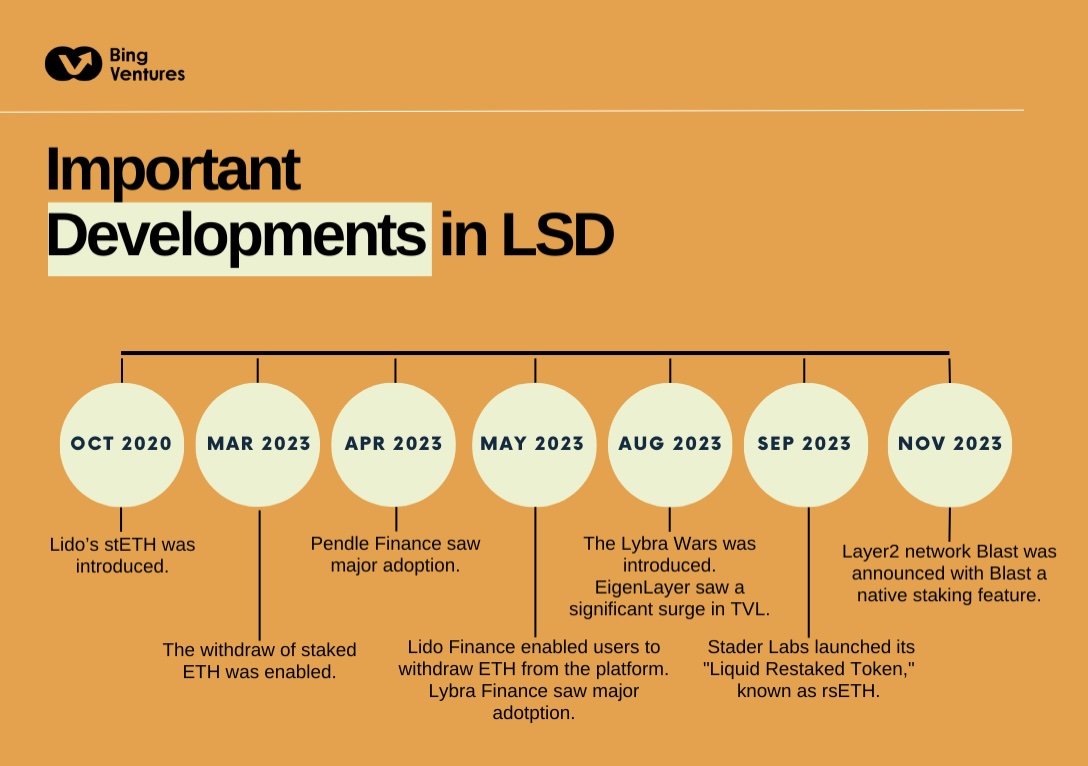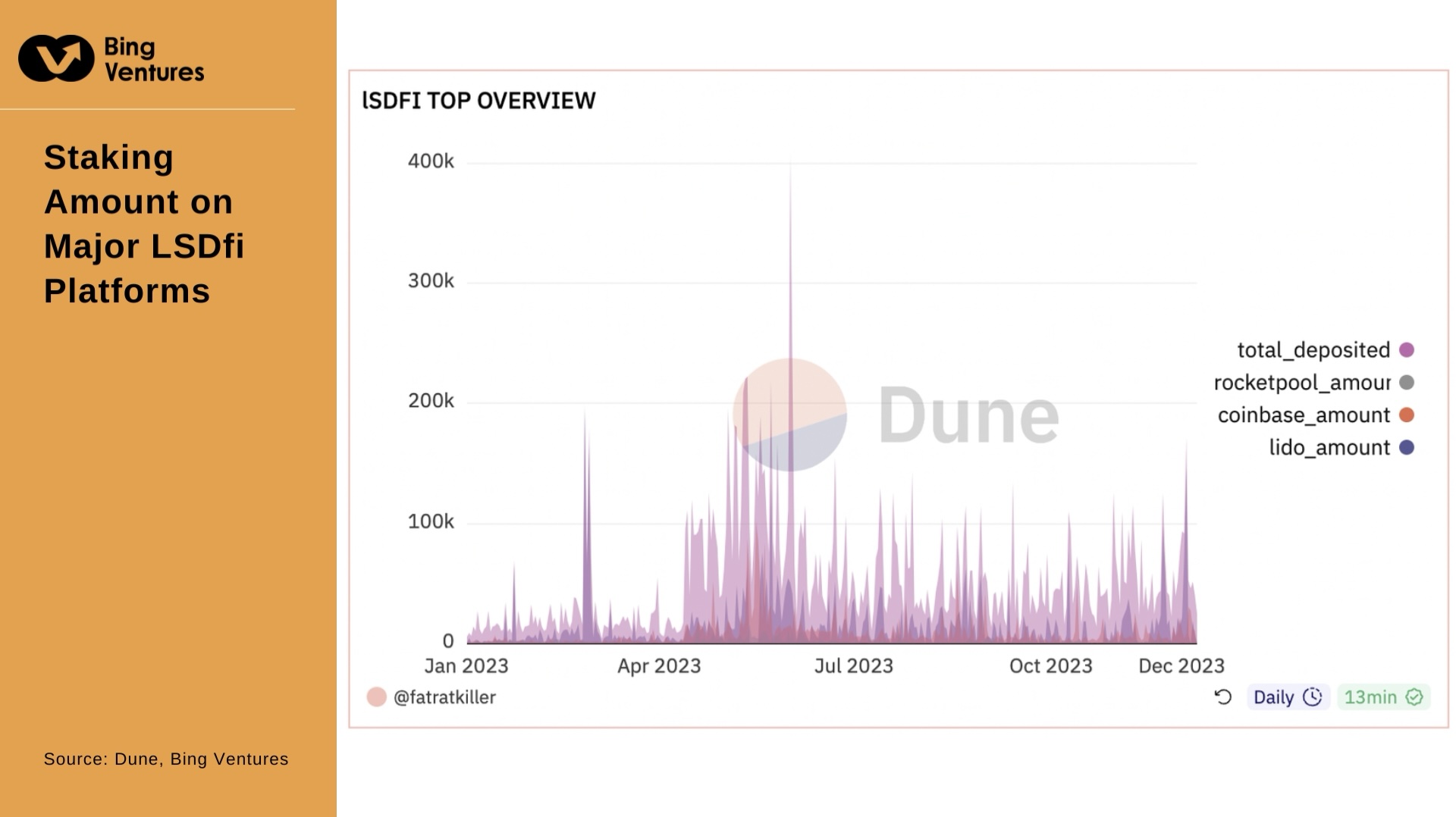HodlX Visitor Submit Submit Your Submit
LRTs (liquid restaking tokens) and the emergence of layer two resolution Blast are powering a brand new wave in DeFi staking.
On this article, we’ll take a look at the backdrop behind this improvement, what it means for DeFi staking and what the most important developments are within the area.
Liquid restaking tokens he latest innovation in LSDs

Supply: Bing Ventures
LSD (liquid staking derivatives) have been an space within the Ethereum ecosystem that has demonstrated exemplary innovation and adaptableness, particularly after the Shanghai improve.
Lido Finance, a platform that performed a crucial function in refining the Ethereum staking mechanism, was the place it began.
With its revolutionary resolution, Lido unlocked the liquidity of staked belongings in Ethereum, fixing a serious challenge within the Ethereum staking mechanism.
Lido permits customers to earn staking rewards on Ethereum with out locking up belongings, marking a serious shift from the standard inflexible paradigm of staking.
Pendle Finance was the subsequent to chart new territories within the LSD area. It pioneered yield tokenization on Ethereum, enabling customers to commerce yield and earn a hard and fast yield on their belongings.
This new mannequin opened up new approaches for yield optimization and threat administration.
The hunt for larger yields and fuller utilization of staked belongings, nevertheless, has no finish. Restaking protocol Eigenlayer emerged with a extra complicated mannequin.
Eigenlayer permits stakers to reallocate their staked belongings to safe further decentralized providers on the Ethereum community.
This not solely will increase stakers’ total rewards but in addition enhances cryptoe-conomic safety and resilience of the complete Ethereum community.
Nonetheless, a serious problem emerged. Restaked belongings grew to become fragmented and illiquid, hampering the exercise and composability within the DeFi area. This was the place LRT got here into play.
This innovation unlocks the liquidity of restaked belongings and additional will increase stakers’ rewards by enabling them to take part in DeFi.
Customers can deposit LRTs to liquid restaking protocols for added earnings.
With these developments, the LSD area has developed from a place to begin of single-layer staking right into a extra complicated and multifaceted ecosystem.
Some newer happenings, such because the emergence of Blast, replicate this development. Blast is an EVM-compatible Ethereum layer two networks that gives native yield staking of ETH and stablecoins on its chain.
This has additional democratized staking rewards and elevated the general person expertise by streamlining the method.
The evolvement of the LSD area demonstrated the dynamic surroundings and adaptableness of the Ethereum ecosystem the place improvements are always being created to fulfill customers’ wants for larger liquidity and yield whereas navigating the intricacy and dangers of DeFi.
DeFi’s subsequent large factor LRTs

Supply: Dune, Bing Ventures
Within the realm of DeFi, the emergence of LRTs represents a profound revolution within the conventional staking paradigm.
LRTs symbolize a breakthrough not solely by considering out of the field of single-asset staking but in addition by introducing and facilitating the event of multi-protocol staking.
Via EigenLayer, customers can transcend the boundaries of a single protocol and diversify their rewards by staking ETH belongings throughout a number of AVS (actively validated providers) on Eigenlayer i.e., purposes and networks which can be secured by way of restaking.
This considerably enhances community safety and in doing so injects a extra intricate layer of safety into the entire DeFi ecosystem.
The benefits embodied by LRTs are manifold a major enchancment in capital effectivity, enhanced community safety and substantial financial savings for builders in useful resource allocation.
Nonetheless, we should stay vigilant concerning the accompanying dangers, together with potential penalty dangers, protocol centralization considerations and income dilution attributable to fierce market competitors.
Concerning the market prospects of LRTs, we consider LRT protocols could have an amazing attract for customers with their excessive earnings potential.
LRT protocols supply further income streams for ETH stakers, encompassing not solely the essential staking rewards but in addition rewards from EigenLayer and the potential advantages of token issuance.
Furthermore, by means of incentive measures comparable to airdrops, LRTs have the potential to draw a wider vary of members, thereby driving total DeFi development and making a development that might replicate and even surpass the warmth of the DeFi summer time of 2020.
The development is price listening to. With LRT offering recent impetus, the DeFi area is anticipated to see elevated competitors much like the earlier ‘Curve Warfare,’ and token economics could evolve towards extra complicated veTokenomics fashions.
Within the meantime, as extra AVS are launched, the extra rewards that they provide to LRT holders might develop into a key driver for person acquisition within the LRT area.
In conclusion, LRTs have demonstrated their distinctive worth in unlocking liquidity, enhancing yields and optimizing governance and threat administration.
As such, LRTs are usually not solely a staking software but in addition an important catalyst for DeFi innovation and development.
Their improvement and software might convey profound modifications to the DeFi ecosystem, opening new potentialities for customers, builders and the complete blockchain world.
Related dangers and challenges
Stader Labs has lately emerged as a darkish horse with its launch of Ethereum mainnet’s first LRT rsETH garnering widespread consideration.
With rsETH, customers will be capable to ‘restake’ liquid staked tokens, comparable to Coinbase’s wrapped staked ETH (cbETH), Lido’s staked ETH (stETH) and Rocket Pool’s rETH on a number of totally different networks, minting a liquid token to symbolize their share in a restaking contract.
This enables larger liquidity and suppleness of staked belongings.
With the assist of EigenLayer, rsETH has efficiently achieved large-scale restaking of ETH by streamlining the method for customers getting into the restaking ecosystem, additional reinforcing the decentralization of the Ethereum community.
Nonetheless, such improvements additionally convey dangers.
Ethereum’s founder, Vitalik Buterin, and the co-founders of EigenLayer have each identified that restaking could result in complicated eventualities, posing a menace to the safety of the primary community.
Moreover, with the proliferation of AVSs and LRTs, extreme dispersion of business funds and a spotlight might lead to market instability and weakened governance constructions.
As an rising power, layer two community Blast added extra vitality to the area with its distinctive automated compounding characteristic.
Its innovation lies within the design that it not solely supplies customers with primary staking yields by working with liquid staking protocols comparable to Lido, however it additionally allows customers to obtain further yields from its auto-rebasing stablecoin USDB by working with protocols like MakerDAO.
Though such a mannequin is user-friendly and affords customers extra returns, owing to its impression on the TVL (complete worth locked) composition, it additionally brings in centralization considerations and will increase its sensitivity to market threat.
How Blast’s technique influences the precise utilization of belongings and the dynamics of capital flows inside its ecosystem would be the key.
Blast ought to goal for its TVL composition to shift extra from capital preservation to asset development in order that it may possibly keep good community exercise and ample liquidity in DApps.
Solely on this manner can it actually obtain its objective of driving the expansion of its blockchain community, moderately than merely serving as a deposit platform.
General, whereas each Stader Labs and Blast signify innovation and progress within the staking fashions of the DeFi sector, they aren’t with out dangers that we must always stay vigilant about to make sure the protection and well-being of the Ethereum community in the long term.
A sturdy and sustainable stability must be reached between these improvements and threat administration sooner or later.
Different new paradigms for Ethereum staking
We consider dynamic staking methods like LRTs are having a profound impression on the Ethereum staking market.
Firstly, the automation and effectivity of those methods have lowered the funding threshold, attracting extra particular person traders.
Secondly, as extra funds movement in, market liquidity considerably improves, contributing to the steadiness of the complete DeFi ecosystem.
Furthermore, dynamic staking methods by providing diversified and customised funding choices are driving market innovation and improvement.
Nonetheless, implementing these methods faces technical challenges, notably in setting up environment friendly and correct algorithmic fashions and guaranteeing system safety and resilience towards community assaults.

Supply: Bing Ventures
In the meantime, there are different new paradigms of staking beneath exploration. Let’s have a look.
A brand new mannequin often called the ‘layered staking system’ emerged in response to a maturing market with various investor calls for.
This method distributes staked belongings throughout totally different threat layers, every with various revenue potential and threat configurations.
Low-risk layers supply comparatively secure returns, appropriate for risk-averse traders, whereas high-risk layers cater to these with a better threat tolerance.
The pliability of this method permits traders to allocate belongings primarily based on their threat preferences and market forecasts.
Implementing a layered staking system requires complicated sensible contracts and complicated threat administration methods to make sure liquidity and safety between totally different layers.
Its introduction supplies traders with extra selections and suppleness, propelling the Ethereum staking market in the direction of maturity and diversification.
Contract-based automated staking methods are an fascinating improvement too.
They improve asset administration effectivity and effectiveness by robotically executing staking, unstaking and asset reallocation.
The chance administration functionality of automated staking methods is enhanced by means of particular threat parameters set inside sensible contracts.
As soon as market circumstances set off these parameters, sensible contracts robotically regulate staking positions.
Regardless of challenges comparable to guaranteeing the safety and reliability of sensible contracts, because the safety of sensible contracts strengthens with the development of expertise, automated staking methods are anticipated to see broader purposes.
Moreover, collective staking and profit-sharing fashions allow a number of traders to collectively stake their belongings and share the generated earnings proportionally.
This mannequin makes use of sensible contracts to robotically distribute earnings, providing collaborative wealth development alternatives for small-scale traders.
Sensible contracts play a pivotal function in collective staking by executing revenue distribution and guaranteeing truthful returns for every participant.
Collective staking supplies small-scale traders with alternatives to cut back threat and prices, enhancing inclusivity throughout the DeFi ecosystem.
Lastly, linking staked belongings with RWAs (real-world belongings) is one other revolutionary method within the DeFi area.
Below this mannequin, real-world belongings comparable to actual property and art work are tokenized on the blockchain and function the underlying belongings for staked belongings.
This method supplies liquidity for usually illiquid belongings and affords new sources of funding for house owners of real-world belongings.
Though this mannequin faces challenges comparable to correct evaluation and tokenization of real-world belongings in addition to coping with regulatory and compliance points associated to those belongings the longer term holds the promise of broader purposes for linking staked belongings with RWAs.
This will present conventional asset holders with new funding channels and supply cryptocurrency traders new funding alternatives, deepening the mixing of cryptocurrency markets with conventional finance markets.
In conclusion, the way forward for DeFi staking guarantees additional developments. It’s an space price listening to for each traders and DeFi gamers.
Kyle Liu is the funding supervisor at Bing Ventures and a seasoned crypto analyst and author. He supplies insightful evaluation and analysis on a variety of subjects together with market developments, sector evaluation and rising initiatives. He’s particularly sturdy at offering forward-looking evaluation on DeFi associated subjects.
Comply with Us on Twitter Fb Telegram

Disclaimer: Opinions expressed at The Each day Hodl are usually not funding recommendation. Traders ought to do their due diligence earlier than making any high-risk investments in Bitcoin, cryptocurrency or digital belongings. Please be suggested that your transfers and trades are at your individual threat, and any loses chances are you’ll incur are your duty. The Each day Hodl doesn’t suggest the shopping for or promoting of any cryptocurrencies or digital belongings, neither is The Each day Hodl an funding advisor. Please word that The Each day Hodl participates in affiliate marketing online.
Generated Picture: Midjourney

